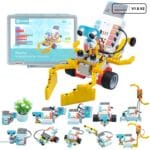
The main goal of this year’s challenge is to integrate abstract scientific information with students’ daily lives while also emphasising the necessity of engineering concepts in modern living. It is also necessary to comprehend the historical development of this way of life as well as the significance of the advent of rudimentary machines in this process. The aforementioned is intended to be accomplished by emphasising the connections between abstract scientific notions such as “force”, “motion”, “friction”, and “pressure” and the operating principles of simple devices and people’s desire to make their lives easier.
The physics underpinning several of the six simple devices included in the challenge (wedge, inclined plane, lever, wheel, and pulley) were quantified by the Greek philosopher Archimedes (ca. 287-212 BC). When used and combined, these machines can provide people with an even greater mechanical advantage, as in the case of a bicycle or an automobile.
Can We Survive On Mars?|Regular Category, Beginners – Advanced
Mars is the most popular and familiar of the planets of our Solar System, as it is the closest to Earth after Venus, but also the one that most resembles it. Since the beginning of the 20th century, the possibility of hosting intelligent life forms, as argued by the American astronomer Percival Lowell, has passed from comics and literature to television and film, with a significant part of public opinion considering this not just possible but certain. At that time, of course, our knowledge of Mars was still minimal, since our technological capabilities did not allow us to clearly distinguish details on its surface.
The systematic study of the Red Planet, and at the same time the first scientifically documented refutation of Lowell’s Martians, began in 1965 when Mariner 4, with its first close-up photographs, revealed a dead and frozen world, a world without vegetation and canals, without cities and Martians, a world hostile to life with polar temperatures. arid and deserted. Six years later, Mariner 9 was also embarking on its journey to Mars. His greatest discovery, and at the same time the first serious evidence of the existence of water on Mars in his past, was a vast system of cracks, faults, ravines and drainage channels. This giant fault has obvious traces of erosion from water that has long been lost.
Viking 1 and 2 continued exploring the Red Planet in 1976. Some 21 years later, the Pathfinder mission carried Sojourner, the first robotic vehicle that could move on its surface, to the Red Planet, which chemically analyzed soil composition and collected weather data. In June 2003, The European Space Agency ESA launched the Mars Express orbiter to Mars, whose data helped astronomers explore fundamental questions about geology, atmosphere, water history and the possibility of microbial life. In March 2006, NASA launched the Mars Reconnaissance Orbiter (MRO). With the help of his data, scientists calculated that the north pole of the planet is covered by 821,000km of3 ice, while several more minerals were discovered that can only be formed by the influence of water. Two years later, NASA’s Phoenix landed on Mars, analyzing the chemical composition of soil and subsoil samples and confirming the existence of subsurface ice. digging with the help of his robotic arm his icy surface.
The Curiosity rover, which landed on Mars in August 2012, is the largest and heaviest spacecraft to date to land on Mars. Its successful landing was a “gamble” for scientists, who wanted to find out whether it is possible and what difficulties hide the mission and landing of the much bulkier payloads that will be required in the future for its manned exploration. Curiosity’s most important discoveries include the confirmation of the existence of carbon, oxygen, hydrogen, phosphorus and sulfur, the building blocks of life, as well as the existence of organic molecules. However, these discoveries in no way prove the existence of simple life forms on the Red Planet, neither now nor in the past. The MAVEN orbiter entered orbit around Mars in September 2014. The main goal of MAVEN’s mission is to determine exactly how the planet’s atmosphere and water have been lost over time. There are several ways in which a planet can lose some of its atmosphere. In the case of Mars, however, what is thought to have happened was the continuous erosion of its atmosphere by ultraviolet radiation and solar wind. So far, MAVEN data confirm this scenario. Collecting and researching all this data, Mars looks colder than the Arctic and drier than the Sahara. However, we have discovered large amounts of ice and more recently dark lines that are likely formed by the seasonal flow of brackish water. According to all indications, billions of years ago, Mars was a much hotter and wetter planet with a dense atmosphere and water flowing into rivers and accumulating in lakes and seas.
The orbiters and robotic vehicles that landed on its surface continue to collect data, trying to find the answers, and at some point the first astronauts will walk on the surface of the Red Planet. The farther we aim into space, the greater the challenges and risks we will face. The longer a manned mission lasts, the more supplies it will have to carry, the better it will have to be shielded against harmful radiation and therefore the more weight it will have. The development and testing of the technologies necessary to build new, more powerful and efficient rockets and spacecraft has by no means been addressed, and the scientists and engineers working on these plans are not yet able to guarantee the safety of astronauts participating in long-duration missions in the future. Living astronauts in conditions of weightlessness for a long time causes muscle atrophy and osteoporosis. Their exposure to the dangerous radiation of solar flares and cosmic rays multiplies their risk of dying from cancer. This same risk will be faced by the first astronauts to set foot on Mars in the future, since this planet does not have an ozone shield and a planetary magnetic field that would protect them.
Survival on Mars requires a multifaceted approach that includes advanced technology, sustainable resource management, strong habitats, and integrated health and safety planning. Collaborative international efforts and continuous innovation will be key to making Mars a viable destination for human exploration and potential colonization.
Free webinars for coaches in the context of the National STEM Contest 2025
Soon…
Visit the coaches’ forum and ask your questions to the category supervisors!
Παράλληλη κατηγορία “1913: Η απελευθέρωση των Ιωαννίνων” μόνο για μαθητές της Ηπείρου
Η δράση εκπαιδευτικής ρομποτικής με το ιστορικό θέμα «1913 : Η απελευθέρωση των
Ιωαννίνων» πραγματοποιείται στα πλαίσια εορτασμού των 110 χρόνων από την
απελευθέρωση της πόλης των Ιωαννίνων. Στόχος αυτής της πρόκλησης μη διαγωνιστικού χαρακτήρα, είναι η γεφύρωση του παρελθόντος
και του μέλλοντος της πόλης, προσεγγίζοντας, με ουσιαστικό τρόπο, σημαντικούς
τομείς, όπως η τεχνολογία, η μηχανική και ο προγραμματισμός. Δίνεται η δυνατότητα στους μαθητές να αποκτήσουν σύγχρονες γνώσεις και δεξιότητες εχέγγυα για το
μέλλον τους και ταυτόχρονα να έρθουν πιο κοντά στην ιστορία του τόπου τους,
γνωρίζοντας τα γεγονότα και αντιλαμβάνοντας τη στρατηγική που ακολουθήθηκε για
την απελευθέρωση της πόλης από τον Οθωμανικό ζυγό στις 21 Φεβρουαρίου του 1913.
• Επιτρεπτές ηλικίες διαγωνιζόμενων: Ε’ Δημοτικού μέχρι Α΄ Λυκείου (10-16 ετών)
• Σε κάθε ομάδα επιτρέπεται η συμμετοχή ενός μόνο μέλους ηλικίας κάτω των 10
ετών.
• Κάθε ομάδα αποτελείται από 3 έως 4 μαθητές και από 1 προπονητή.
Για περισσότερες πληροφορίες κάνετε κλικ εδώ για να επισκεφτείτε το website
Οι ομάδες θα διαγωνιστούν στον Περιφερειακό Αγώνα στην Ήπειρο, 19/03/2023 στο 3ο Δημοτικό Σχολείο Iωαννίνων “MAPOYTΣEIO”.
Έχετε απορίες σχετικά με τους κανόνες ή με τη διαγωνιστική διαδικασία;
Επισκεφθείτε το forum των προπονητών και θέστε τις ερωτήσεις σας στους υπεύθυνους των κατηγοριών!

Επίσημος προμηθευτής εξοπλισμού για τον Πανελλήνιο Διαγωνισμό Εκπαιδευτικής Ρομποτικής είναι η Διερευνητική Μάθηση.
Επιτρεπόμενα υλικά
• Μικροελεγκτές, κινητήρες και αισθητήρες από τα πακέτα LEGO NXT, LEGO SPIKE
ή LEGO EV3, και ο αισθητήρας χρώματος της HiTechnic, (HT color sensor). Κάθε
ομάδα μπορεί να χρησιμοποιήσει μόνο έναν μικροελεγκτή, μέχρι 4 κινητήρες και
μέχρι 4 αισθητήρες.
• Δομικά στοιχεία από οποιοδήποτε πακέτο της LEGO. Απαγορεύεται η χρήση
οποιουδήποτε άλλου δομικού ή στερεωτικού υλικού.
Φόρμα Εγγραφής
(**Ο αριθμός συμμετοχών ισοδυναμεί με τον αριθμό των ομάδων που θέλετε να δηλώσετε. Μπορείτε παρακάτω να βρείτε το έντυπο γονικής συγκατάθεσης και να το προσθέσετε στη φόρμα σας συμπληρωμένο, ένα για κάθε μαθητή. Το έντυπο θα το έχετε μαζί σας και την ημέρα του διαγωνισμού εκτυπωμένο για να το καταθέσετε στους υπεύθυνους.)






